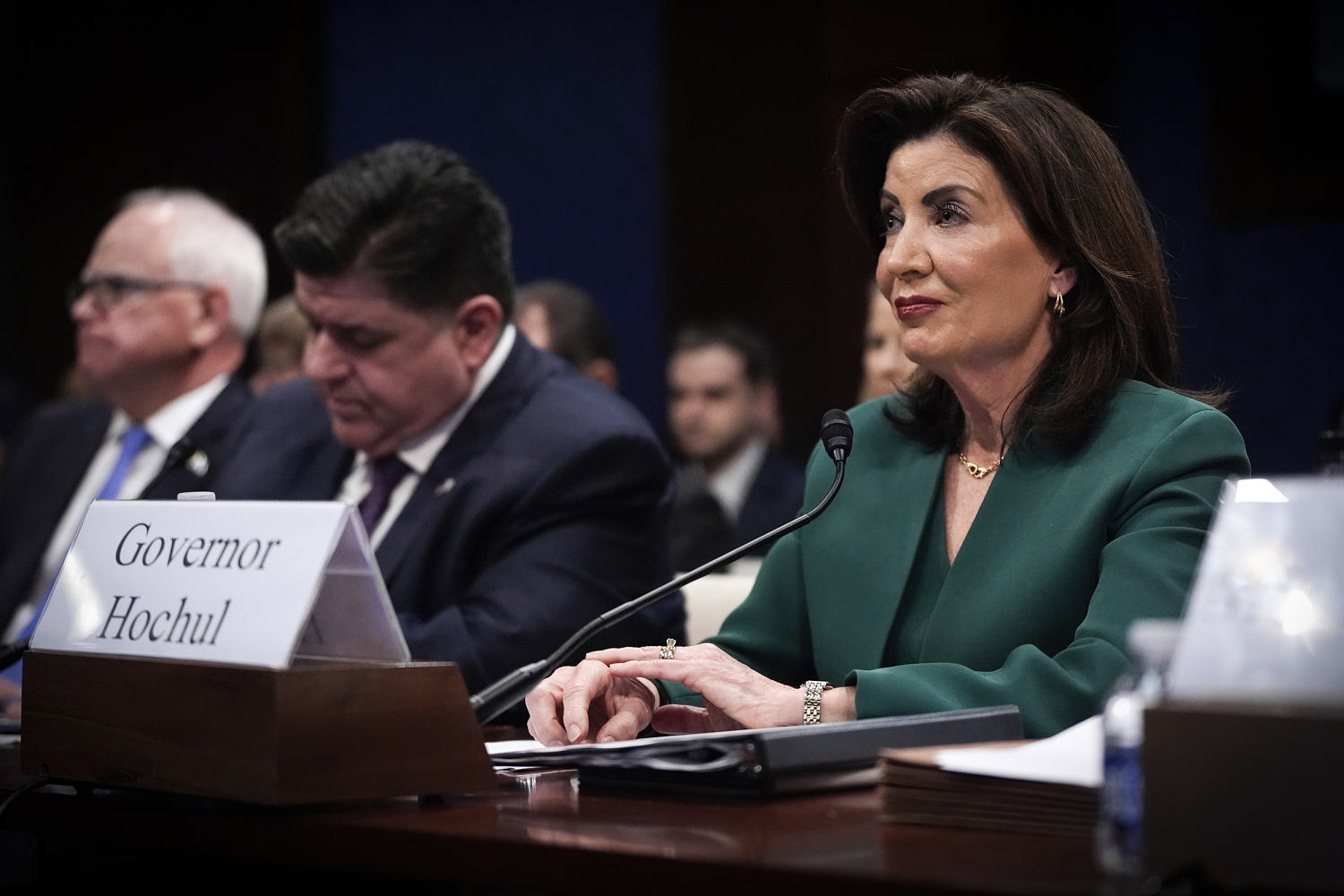New York Democrats unveil their own mid-decade redistricting scheme, targeting future elections


As Texas Republicans slowly move forward with plans to redraw congressional maps mid-decade, Democrats in New York plowed ahead Tuesday with their own scheme to counter any GOP redistricting efforts.
But the effort faces a long, arduous path forward, and it wouldn’t be scheduled to go into effect for years, illustrating the limited options at Democrats’ disposal as they hunt for ways to counter the GOP redistricting play in Texas.
Legislative Democrats in the blue stronghold unveiled a bill that would allow state lawmakers in Albany to conduct mid-decade redistricting — but only if another state were to do it first.
The proposal would, if it were enacted, effectively set up the prospect of a national redistricting tit-for-tat between Republicans and Democrats, with control of the House of Representatives in Washington potentially on the line.
However, there are key differences between what’s happening in New York and what’s happening in Texas, including the timing of any actual map changes. Texas Republicans are looking to immediately enact new district boundaries for the 2026 elections.
The bill in New York, which is technically a legislatively referred constitutional amendment, would allow the Legislature to redraw congressional districts if another state engaged in mid-decade redistricting.
It would have to pass the Legislature in two consecutive sessions — and then still be approved by voters in a ballot measure. In theory, that means that whatever new maps that would be created wouldn’t be in place until the 2028 elections.
“New York will not sit idly by as other states work to disenfranchise voters,” state Senate Deputy Majority Leader Michael Gianaris, who introduced the bill in his chamber, said in a statement. “States must play by the same rules for a legitimate democracy to exist, and if red states are intent on corrupting the redistricting process, New York will respond.” Democrats introduced an identical measure in the Assembly.
The redistricting process in states typically occurs at the start of each new decade, when new census data is available.
In New York, that process has been controlled since 2014 by the state’s Independent Redistricting Commission — a bipartisan body charged with creating fair maps for the Legislature to approve. The commission was created when New York voters passed a constitutional amendment changing the redistricting process. Previously, the Legislature controlled the entire process for legislative and congressional maps.
Gianaris’ office said the effort is a direct response to Texas Republicans’ ongoing attempt to redraw their own congressional maps ahead of schedule — a scheme that could help pad the GOP’s narrow majority in next year’s midterms.
A fight with national implications but different state-by-state rules
At the urging of President Donald Trump, Texas Gov. Gregg Abbott convened a special legislative session that kicked off last week that includes congressional redistricting on lawmakers’ formal to-do list. The session, which runs 30 days, is ongoing. Texas lawmakers haven’t yet publicly unveiled their choices for the redrawn maps.
The unscheduled effort has triggered a ripple effect, with governors across the country floating the possibility of following suit to either add to or counter the plan — depending on their party affiliations. That could include potential actions to benefit congressional Republicans in Florida and Ohio.
In the case of New York, Gov. Kathy Hochul said last week — in a precursor to the introduction of Gianaris’ bill Tuesday — that “all’s fair in love and war” and that she’d “closely” consider any proposed actions.
In response to questions about whether Hochul supported the proposal, spokesperson Emma Wallner referred NBC News to comments last week on “The Jim Acosta Show.”
“It’s something we’re looking at very closely,” Hochul said on the podcast. “We’re watching what’s happening there. And I do not like a scenario where we are disadvantaged when we’re following the rules. More to say on that later.”
Another big blue state where Democrats have signaled they could move forward with early redistricting is California, where Gov. Gavin Newsom, a potential 2028 presidential contender, has raised the idea.
As is the case in New York, an independent commission empowered by the state constitution controls the redistricting process in California. Undoing that process would be similarly complicated, much more so than in states where redistricting is just a matter of passing a state law, though Democrats are talking up the idea anyway.
House Minority Leader Hakeem Jeffries, D-N.Y., will travel Wednesday to Austin, where he plans to meet with Democratic state lawmakers and members of Congress to discuss the GOP’s redistricting push there, according to a source familiar with the meeting.
Before congressional lawmakers left Washington for a five-week summer recess, Jeffries huddled with members of the California delegation. The meeting included a discussion about whether Democrats in California should redraw its congressional lines in response to Texas, said a source in the room, who added that Jeffries’ message was that every option should be considered.
In recent interviews with NBC News, California members of Congress indicated they’d support such a plan.
“If Texas is going to rig the system, then I think we can’t just sit back and watch it and do nothing and say we’re going to have our hands tied,” said Rep. Nanette Barragan, D-Calif., a member of Jeffries’ leadership team and the former chair of the Hispanic Caucus. “We’ll have to keep our eyes on Texas, but I think we need to look at all options.”
Another California Democrat, Rep. Ami Bera, a member of the leadership team for House Democrats’ campaign arm, agreed Democrats shouldn’t sit by and do nothing.
“I’m a fan of independent redistricting commissions, but the fact that Republicans are playing by a different set of rules, I think it doesn’t make any sense that we’re disarming ourselves,” Bera said. “If they’re going to play by a set of rules and put politics above everything, we’ve got to play hardball, too.”
Bera said he’d be fine giving up some Democratic parts of his district to give an edge to Democrats facing tougher races. “I’m willing to give up some voters to get the majority again,” he said.
Rep. Mark Takano, D-Calif., said it “can’t be the case that only Republican-controlled states can maximize the mid-decade redistricting.”
But many officials in California and elsewhere — and not just Republicans — strongly oppose any and all efforts to circumvent the commission, which voters created in a ballot measure.
“You can’t fight gerrymandering with more gerrymandering. It is a shortsighted plan,” Patricia Sinay, a member of the California Citizen Redistricting Commission, said on a call with reporters Tuesday. “Handing the power to incumbent legislators, lobbyists and special interests will bring back the political gamesmanship that brought us to independent redistricting in the first place.”
Other opponents of efforts in California to redraw maps early said doing so would be likely to strip Black and brown voters of adequate representation.
“Redistricting is not as cut and dry as some are purporting it to be,” said Russia Chavis Cardenas, the deputy director of the California branch of government watchdog group Common Cause. “We know that gerrymandering hurts Black, brown and poor communities the most — so for our communities of color, this is not a partisan issue; this really is a representation issue.”
“We cannot let the Trump administration bait us into abandoning our communities of color in the name of political gamesmanship,” she added. “By responding to fire — the efforts in Texas — with fire, Democrats risk permanently damaging their relationship with Black and brown voters and ultimately diluting the voting power of Black and brown voters.”



